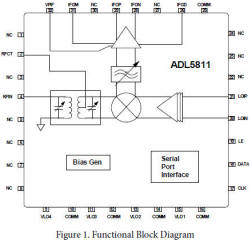|
|
|
|
Analog Devices Press Release - May 10, 2011
|
Analog Devices Makes Technical Advances in RF Technologies and Launches
Industry-First Mixers with Wideband
Performance for
Multi-Band Communications
-- ADI’s single- and dual-channel RF mixers are first in industry to incorporate wideband LO amplifier,
programmable RF balun and IF filter, and IF amplifier to support wideband operation for wireless
infrastructure and software-defined radio applications.

ADI’s single- and dual-channel RF mixers are first in industry to incorporate wideband LO amplifier,
programmable RF balun and IF filter, and IF amplifier to support wideband operation for wireless infrastructure
and software-defined radio applications.
NORWOOD, Mass.--( BUSINESS
WIRE)-- Analog Devices, Inc. (ADI), a world leader in high-performance semiconductors for signal processing
applications and RF ICs (radio-frequency integrated circuits), today introduced the industry’s most highly
integrated wideband passive mixers for communications applications. The
ADL5811 single-channel and
ADL5812 dual-channel mixers deliver unmatched linearity, low distortion and low noise combined with wideband
frequency performance. The new devices enable multiband, single-board receiver designs by combining a wideband LO
(local oscillator) amplifier, a programmable RF balun, a high-linearity mixer core, a programmable IF filter, and
an IF amplifier.
Watch video on the features of the new
ADL5811 and ADL5812 RF mixers.
 ADI’s
new passive mixers extend across a 700-MHz to 2800-MHz frequency range in a single device while delivering input
IP3 (third order intercept) of 24 dBm, an 11 dB SSB noise figure and 7 dB of power conversion gain. These
performance specifications are maintained across the full operating frequency range. The
ADL5811 and
ADL5812 passive mixers are designed for wideband wireless infrastructure applications and software-defined
radio applications, including multi-band/multi-standard cellular base station receivers, wideband radio link down
converters, multi-mode cellular repeaters, and picocells applications. ADI’s
new passive mixers extend across a 700-MHz to 2800-MHz frequency range in a single device while delivering input
IP3 (third order intercept) of 24 dBm, an 11 dB SSB noise figure and 7 dB of power conversion gain. These
performance specifications are maintained across the full operating frequency range. The
ADL5811 and
ADL5812 passive mixers are designed for wideband wireless infrastructure applications and software-defined
radio applications, including multi-band/multi-standard cellular base station receivers, wideband radio link down
converters, multi-mode cellular repeaters, and picocells applications.
“Wireless receiver designers typically have had to choose between an active mixer, which offers excellent
wideband operation and moderate spurious-free dynamic range, or a passive mixer, which has greater SFDR
performance but much narrower operating bandwidth,” said Peter Real, vice president, Linear and RF products,
Analog Devices. “The ADL5811 and ADL5812 passive mixers eliminate the need for this trade off by giving engineers
the linearity, distortion and noise performance they need while also supporting true wideband frequency
operation.”
Download data sheet, see product pages:
http://www.analog.com/ADL5811
or http://www.analog.com/ADL5812
Find application notes and technical articles about RF/wireless and communications solutions from ADI: http://communications.analog.com/en/segment/cmmn.html
The high performance across 700 MHz to 2800 MHz of the new passive mixers is the result of three technical
advances, most significantly the development of a limiting LO amplifier capable of generating a high-voltage,
fast-rise-time, square wave over a wide bandwidth with no DC current penalty compared to existing narrow band
mixers.
The second technique involves the integration of a tuned, RF balun structure to ensure a
well-balanced RF signal is applied to the FET mixer. Previously, narrowband mixers incorporated an RF balun
consisting of a magnetic or transmission line transformer, which provided low loss but only moderate bandwidth.
A third technique addresses the potential for the passive mixer’s structure to generate a composite signal that
could result in the early compression of the IF amplifier. ADI reduced the amplitude of the unwanted sideband into
a load by designing a tuned filter network to provide the proper sum termination as a function of the RF and LO
frequencies.
The frequencies of the ADL5811 and ADL5812 can be easily changed using a three-wire SPI
(serial port interface), which allows designers to tune the mixers with no need for external impedance matching
components. Performance can be further optimized by digitally adjusting the DC bias voltage to the passive mixer
gates. To minimize power dissipation, each channel of the dual-channel ADL5812 can be enabled or disabled
independent of the other. For DPD (digital pre-distortion) transmit observation receivers or non-diversity
applications, the single-channel ADL5811 can implement a single receiver chain in a multi-channel or multi-band
platform.
ADL5811 and ADL5812 Passive Mixers Features and Benefits
- Limiting LO amplifier achieves wide bandwidth
- Tuned RF balun structure ensures well balanced RF signal
- Tuned IF filter network provides proper sum frequency termination
- Single Ended, 50-Ohm input matched for the RF and LO input
- Wideband 700-MHz to 2800-MHz frequency range
- Input IP3: 24 dBm
- SSB Noise figure: 11 dB
- Power conversion gain: 7 dB
Availability, Pricing and Complementary Components
As part of a complete wireless
communications signal chain, the ADL5811 and ADL5812 passive mixers can be designed together with ADI’s AD8375/6
IF DGA or ADL5561/2 differential amplifier and the ADF435X series of synthesizers for a complete receiver signal
chain.
RF IC Portfolio Covers Entire RF Signal Chain
Using a unique combination
of design skills, system understanding and process technologies, Analog Devices offers the broadest portfolio of
RF products covering the entire RF signal chain from industry-leading high-performance discrete RF function blocks
to highly-integrated multi-functional single-chip RF solutions. These products are also supported by a wide range
of free design tools, evaluation boards and other design resources to ease the development of RF systems. For more
information, visit: www.analog.com/rf.
Contact
Analog Devices, Inc.
Bob Olson
781-937-1666
Email:
bob.olson@analog.com
Date Posted 5/11/2011
|
|
|
|